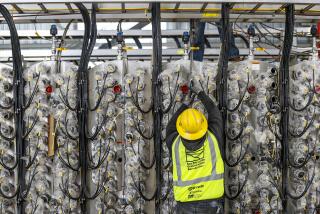Board Asks EPA to Force Firms to Clean Up Water in San Gabriel Valley
More than two decades after the discovery of dangerous chemicals in the San Gabriel Valleyâs drinking water supply, state officials Monday called upon federal authorities to get tough on the polluters and force them to pay for the cleanup.
The state agency coordinating the cleanup and several lawmakers questioned why the U.S. Environmental Protection Agency has allowed the 20 corporations deemed responsible to drag their feet on cleaning up contaminated ground water beneath Azusa, Baldwin Park and Irwindale.
The San Gabriel Basin Water Quality Authority board said the corporations have repeatedly blown deadlines to sign an agreement with water providers to address the problem. The board, meeting Monday at Baldwin Park City Hall, passed a resolution calling on the EPA to take legal action against the companies if they miss the next deadline--Dec. 17.
âWeâve lost 31 wells to contamination, and weâre going to lose more unless we get the cleanup going,â board Chairman Bob Kuhn said.
State legislators gave the EPA and the companies a tongue-lashing at the hearing about the massive aquifer, which serves a million people.
âWe are tired of false promises and deadlines not met,â said Assemblyman Ed Chavez (D-La Puente). The polluters âneed to come forward and pay for the cleanup. Our patience has worn out.â
Assemblyman Dennis Mountjoy (R-Monrovia) added, âIf litigation is what it takes, so be it.â
The aquifer was declared a Superfund site by the EPA in 1984, five years after the discovery of solvents there. The EPA deemed 20 companies responsible for the pollution.
Efforts to clean up the aquifer, however, were complicated in 1997 when perchlorate--a hazardous byproduct of rocket fuel--was detected in the water supply and linked to Aerojet General Corp.âs Azusa plant. A process had to be developed to deal with that and another toxic substance, known as NDMA, or n-nitrosodimethylamine, used by defense contractors.
In 1999, 11 of the companies agreed in principle to pay a combined $200 million, but a deadline last year to sign a binding agreement passed. In July 2000, the EPA issued an order requiring the companies to pay the $200 million.
If an agreement is not reached, the federal government can use the Superfund law to sue the companies for the cleanup costs.
Norman Dupont, an attorney for Reichhold Inc., an Azusa manufacturer, said some firms have spent a combined $15 million this year on water treatment facilities and also paid some water providers to import water where needed.
Dupont, speaking at the hearing on behalf of the smaller firms, questioned why Exxon Mobil--one of the wealthiest companies involved--has not participated in negotiations.
Bob Anderson, Aerojetâs deputy general counsel, said his company has provided $10 million in the last year for cleanup and placed an additional $40 million in an escrow account.
âAerojet has been a good neighbor,â he said. âWe have the lionâs share of the financial burden.â
Anderson said critics need to remember that much of the problems stem from the 1950s and â60s, when environmental guidelines were different. âThese were patriotic acts of a company trying to win the Cold War,â he said of his companyâs work during that time.
Because perchlorate and other possible carcinogens have knocked numerous wells in the San Gabriel Valley out of action, officials said they have been forced to import Colorado River water, which costs far more than ground water.
Water officials warned that if left unchecked, the contamination could spread into southeastern Los Angeles County through Whittier Narrows, polluting the supply to 2 million more homes.
âThe plume spreads like a drop of oil in a bucket,â said Paul Carver of Suburban Water Systems, which lost half of its production in the San Gabriel Valley last summer because of contaminated wells.
Anderson said he thinks a cleanup agreement is possible by Dec. 17. EPA Superfund site manager Wayne Praskins refused to say what the agency will do if the deadline passes, calling the date âdoable.â
More to Read
Sign up for Essential California
The most important California stories and recommendations in your inbox every morning.
You may occasionally receive promotional content from the Los Angeles Times.











